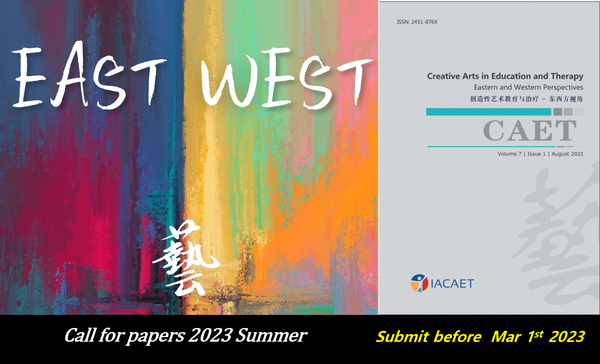The summer 2023 issue of the CAET Journal offers a focus on the power of the arts in the social net as a way to cross knowledge borders and expand dialogue in service of relational, transformative practices. The global collection includes theoretical, East/West perspectives, philosophical positions, Laban analysis, original experimental, and artistic and art-based research, with real-world clinical and educational applications. There is a thread throughout this collection that brings alive the role of research that illuminates underrepresented topics, intended to shine a bright light on the importance of artistic intention and empathy in theory, practice, and research. These qualities and characteristics of the authors’ work and their perspectives are at the heart of this issue and philosophy of IACAET.
We begin with reflection and a return to an article written by our co-editor-in-chief emeritus Shaun McNiff in 2020. Addressing vital concepts as part of healing and stabilizing through the pandemic, in his postscript to “‘Tears on the Flowers’: Worldwide Natural Experiments of Art Healing,” he reflects on core concepts and the timing of the paper, deeply dives into the multiplicity, yet simplicity in the creative process and the medicinal role of empathy in those contexts before, during, and through the COVID-19 pandemic specifically.
Following Shaun’s postscript, we continue with “Psy Fever/Psycho-boom: The Mental Picture of a Transforming China.” presented by Mengzhu An. This article explores the phenomenon of what is conceptualized as “popular participation in psychotherapy and training in urban China” and the corresponding social and cultural responses.
In our next article, Shaobo Liu presents “Dance Creation and Analysis under the Perspective of LBMS: Using Glowing Ocean as an Example.” The artistic and practice-based project analyzed the creative process of a ballroom duet piece with a focus on a deep artistic and methodical examination of the role of creativity. A major theme from the combination of analysis and artistic process was the importance of how dance conveys meaning through metaphors.
Next, we welcome Jun Hu, who presents an art-based research project named, “Contemplating the 3P Theory to Set Grounds for Criteria for the Understanding of Arts-based Research.” The 3Ps stand for possibility, plausibility, and probability. Hu shares a philosophical position with the concept of research as a spectrum of inquiry with varied objectives of prediction. Through embarking on the journey of inquiry by way of seven artful expressions that explore reason and irrationality, Hu shares the insight that ABR is a necessary form of research, and that it is not segregated from normative research, but interrelated with it.
Michal Lev, Israella Klein-Bentsur, Daniella Barzilai, and RenannaShalmonin Israel, bring light to issues of domestic violence, paternal representations, and artmaking with clay. In their article, “Molding the Fear: Representations of Fatherhood in Clay by Violent Men,” the authors explored paternal representations of violent men that arise in artmaking with clay in a group setting.
Welcoming Tal Hanan to this issue, and the article, “Israeli Teachers and Expressive Therapists Understanding of Selective Mutism,” the topic of childhood selective mutism is illuminated in this arts-based research and phenomenological qualitative inquiry. By gathering information in the form of opinions, experiences, and art making, from 13 participants who took part in a professional workshop, the author was able to capture important data that informs professional development and exposure of this multifaceted topic.
Next, Iolanda Di Bonaventura presents the article, “What Flows Underneath the Disease,” addressing women who experience chronic pelvic pain, and coping and self-compassion strategies using dance/movement therapy (DMT). Explorations of using DMT tools worked with the participants’ relationship to the disease, its meaning in their personal stories and histories, and the processes of rediscovery of one’s psycho-bodily resources to listen to and actively dialogue with one’s pain.
Artist Spotlight
This is one of our newer features, introduced in the Winter 2022 edition, and in this issue, we are honored and delighted to feature an article spotlighting Sylvia Magogo Glasser presented by our coeditor, Vivien Speiser. Titled“A Tribute to the Work of Sylvia Magogo Glasser: Dancer, Dance Educator, Choreographer, Social Activist, and Visionary,” the article is a compilation of interviews with Sylvia, writings, websites, and articles that describe her work, and the several generations of performers, students, educators, and dancers she has influenced. A particular highlight is Sylvia’s reflections on her seminal work, Transformations from 1991, and her comments about the anthropology in the work we do that is illuminated in that performance that integrated cultural and spiritual practices, and the importance of multiple histories and ways of understanding Southern African dance.
Book Review
This edition features a book review written by Giselle Ruzany on Dance/Movement Therapy (DMT) for Trauma Survivors: Theoretical, Clinical, and Cultural Perspectives by Rebekka Dietrich-Hartwell and Anne Margrethe Melson. This timely publication provides rich information for DMTs and clinicians alike who are interested in contemporary trauma and DMT theory and practice and is rich with case examples that address the impact of current critical social issues in the field of DMT.
We hope you enjoy this edition and share it with your colleagues. Together, as a global network, we continue to build capacity of knowledge, deepen our empathic and relational practices, and expand the interrelational possibilities of the arts net.



